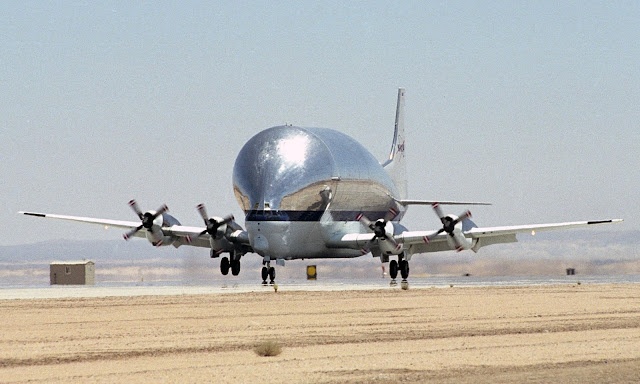This bizarre looking aircraft is one of the strangest airplanes built in the history of mankind. If you pay a closer look, you'll be awestruck with the size and sheer complexity it has. Although built in the 1960s, it still flies to this day. and is named after a fish,
Pregnant guppy. Yes, it is old and cumbersome, but one of a kind.
Why was it Built
During the 1960s,
NASA was having difficulties in transporting its units of the future spacecraft from its manufactures in the west to the launch sites on the east coast. Although the journey was possible through other means of transport than air, but would cost NASA at least 18 days.
With this potential idea of producing a transport aircraft,
John M. Conroy, an American actor, aviator, and a businessman, discussed with aircraft broker, Leo Mansdorf, who had recently acquired a good number of Boeing 377 Stratocruisers, which later on became the main structural component of the pregnant guppy.
 |
For accessing the cargo space of Super Guppy, nose section had to opened
|
Mr. Conroy, later started Aero Spacelines International, with just one customer in mind, NASA. Two years later, the pregnant guppy was flown at
Van Nuys, piloted by Conroy and co-pilot Clay Lacy. Although the propeller-driven Guppy was 3,000lbs heavier than the original
Boeing 377 Stratocruisers, it made the transportation of NASA components easier and faster.
The initial pregnant guppy was constructed using B-377 N1024V, a
Pan Am Super Stratocruiser airframe and parts of B-377 (c/n 15976).
The wings, engines, nose, tail and cockpit remain unaffected, but a 6m of upper fuselage was added, thus giving it an appearance of 'pregnant Guppy'. Unlike, the cargo planes that operate in recent times, the Guppy had to detach its entire rear section to access the cargo bay.
The aircraft (registration N1024V ) served NASA throughout the 1960s transporting various units of space program, and was finally scrapped at Van Nuys in 1979.
 |
| Rear tail section of Mini Pregnant Guppy opened during loading of cargo |
With the space program growing day by day, one pregnant guppy was not enough for NASA, as per the scale of operation, 4 more Super Guppy's were constructed. Unlike its predecessor, the Super Guppy had its own modifications like its cargo bay area being a whopping 39,000 cubic feet, almost 10,000 cubic feet more than the initial pregnant guppy. It had other advantages too, the cargo bay could be accessed through its nose section, thereby making it convenient for loading and unloading goods.
Moreover with an upgraded engine Pratt & Whitney T-34-P-7WA turboprop, making it more powerful and longer range than the initial Guppy.
Even with the World Biggest cargo aircraft, Antonov - 225 used for transporting heavier loads, the super guppy makes it preferable due to its "25ft" accessible cargo space, compared to "15ft" of Antonov-225 Miriya
Where are the Super Guppy's Now
 |
| N941NA of NASA still in service since its first flight in 1965 |
Of the 5 Super Guppy's built, 4 remain on display at various museums and exhibition centres around the globe. Whereas the Super Guppy Turbine (N941NA,) a variant of Guppy line, in which the nose gear was obtained from a
Boeing 707, Thus making it lowered and easily accessible for cargo space, is still in service with NASA.
On November 29, 2019, The Super Guppy Turbine (N941NA) arrived at
NASA Space Kennedy Centre, Transporting the packaged Orion Spacecraft inside. It is the last Boeing 377 Stratocruiser operational in the world.
Reference










No comments:
Post a Comment